Sociology of Gender and Sexuality: Exploring Key Concepts
VerifiedAdded on 2023/06/03
|11
|1932
|458
Essay
AI Summary
This essay provides a sociological perspective on the concepts of gender and sexuality, arguing that they are distinct yet interconnected. It differentiates between sex, which is biological, and gender, which is a social construct encompassing cultural and societal values. The essay explores gender roles, stereotypes, and gendered sexuality, highlighting how these concepts influence individual behavior and societal expectations. It examines how gender roles are established through interactions with the environment, leading to expectations for both men and women. The essay also discusses the impact of these roles on personality traits and the imposition of stereotypes. Furthermore, it analyzes the concept of gendered sexuality and how it relates to societal views and behaviors. The essay concludes by emphasizing the importance of differentiating between sex and gender and understanding the impact of these concepts on human behavior and societal norms.
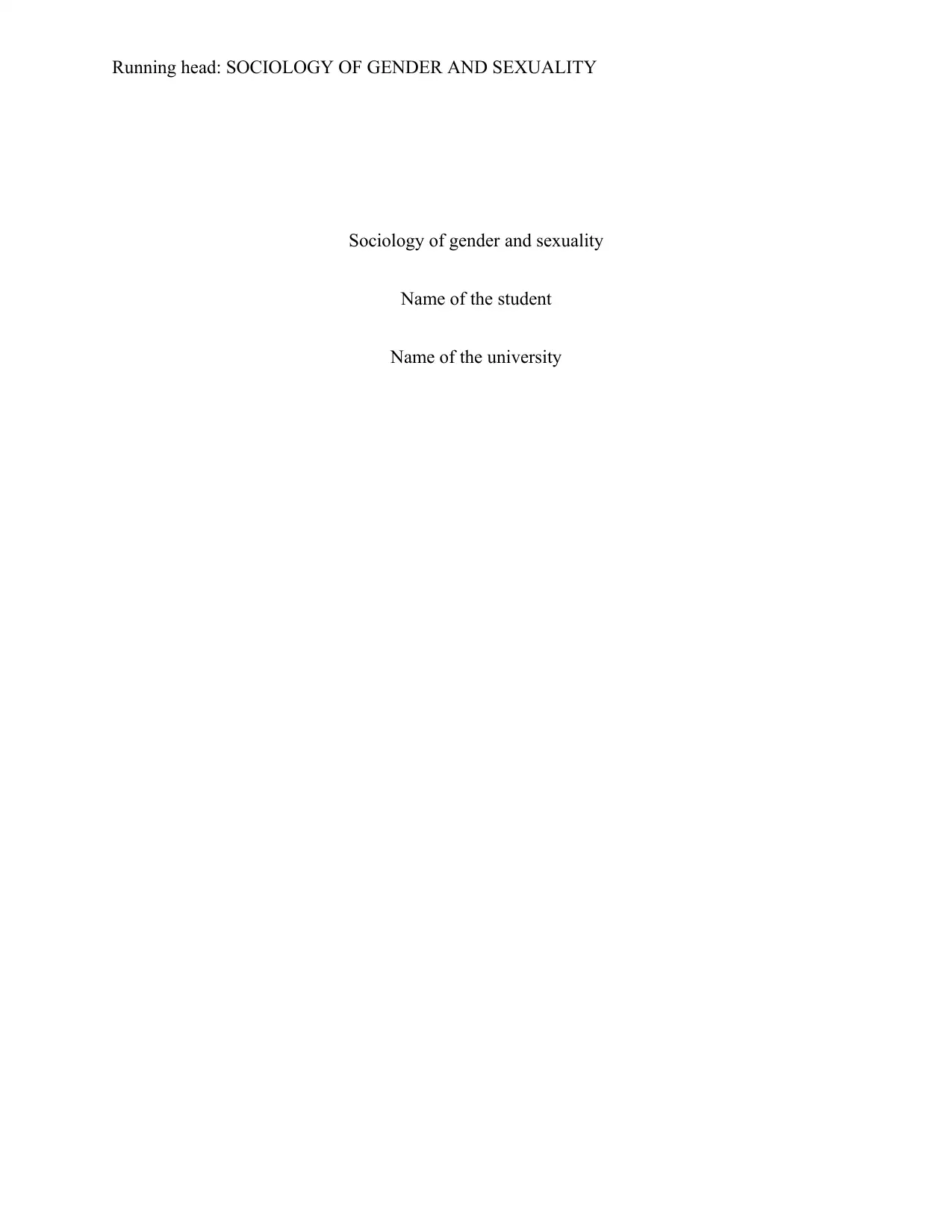
Running head: SOCIOLOGY OF GENDER AND SEXUALITY
Sociology of gender and sexuality
Name of the student
Name of the university
Sociology of gender and sexuality
Name of the student
Name of the university
Paraphrase This Document
Need a fresh take? Get an instant paraphrase of this document with our AI Paraphraser
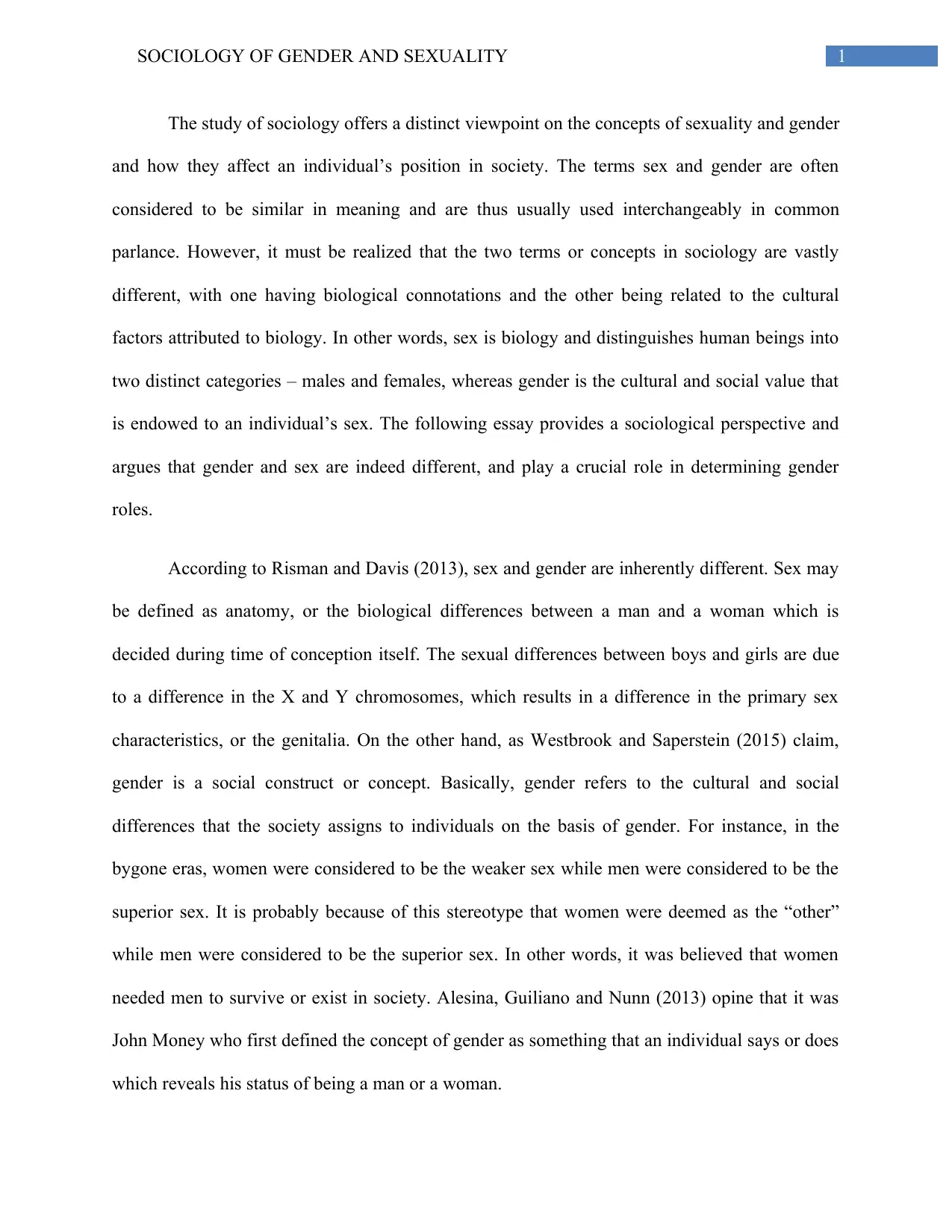
1SOCIOLOGY OF GENDER AND SEXUALITY
The study of sociology offers a distinct viewpoint on the concepts of sexuality and gender
and how they affect an individual’s position in society. The terms sex and gender are often
considered to be similar in meaning and are thus usually used interchangeably in common
parlance. However, it must be realized that the two terms or concepts in sociology are vastly
different, with one having biological connotations and the other being related to the cultural
factors attributed to biology. In other words, sex is biology and distinguishes human beings into
two distinct categories – males and females, whereas gender is the cultural and social value that
is endowed to an individual’s sex. The following essay provides a sociological perspective and
argues that gender and sex are indeed different, and play a crucial role in determining gender
roles.
According to Risman and Davis (2013), sex and gender are inherently different. Sex may
be defined as anatomy, or the biological differences between a man and a woman which is
decided during time of conception itself. The sexual differences between boys and girls are due
to a difference in the X and Y chromosomes, which results in a difference in the primary sex
characteristics, or the genitalia. On the other hand, as Westbrook and Saperstein (2015) claim,
gender is a social construct or concept. Basically, gender refers to the cultural and social
differences that the society assigns to individuals on the basis of gender. For instance, in the
bygone eras, women were considered to be the weaker sex while men were considered to be the
superior sex. It is probably because of this stereotype that women were deemed as the “other”
while men were considered to be the superior sex. In other words, it was believed that women
needed men to survive or exist in society. Alesina, Guiliano and Nunn (2013) opine that it was
John Money who first defined the concept of gender as something that an individual says or does
which reveals his status of being a man or a woman.
The study of sociology offers a distinct viewpoint on the concepts of sexuality and gender
and how they affect an individual’s position in society. The terms sex and gender are often
considered to be similar in meaning and are thus usually used interchangeably in common
parlance. However, it must be realized that the two terms or concepts in sociology are vastly
different, with one having biological connotations and the other being related to the cultural
factors attributed to biology. In other words, sex is biology and distinguishes human beings into
two distinct categories – males and females, whereas gender is the cultural and social value that
is endowed to an individual’s sex. The following essay provides a sociological perspective and
argues that gender and sex are indeed different, and play a crucial role in determining gender
roles.
According to Risman and Davis (2013), sex and gender are inherently different. Sex may
be defined as anatomy, or the biological differences between a man and a woman which is
decided during time of conception itself. The sexual differences between boys and girls are due
to a difference in the X and Y chromosomes, which results in a difference in the primary sex
characteristics, or the genitalia. On the other hand, as Westbrook and Saperstein (2015) claim,
gender is a social construct or concept. Basically, gender refers to the cultural and social
differences that the society assigns to individuals on the basis of gender. For instance, in the
bygone eras, women were considered to be the weaker sex while men were considered to be the
superior sex. It is probably because of this stereotype that women were deemed as the “other”
while men were considered to be the superior sex. In other words, it was believed that women
needed men to survive or exist in society. Alesina, Guiliano and Nunn (2013) opine that it was
John Money who first defined the concept of gender as something that an individual says or does
which reveals his status of being a man or a woman.
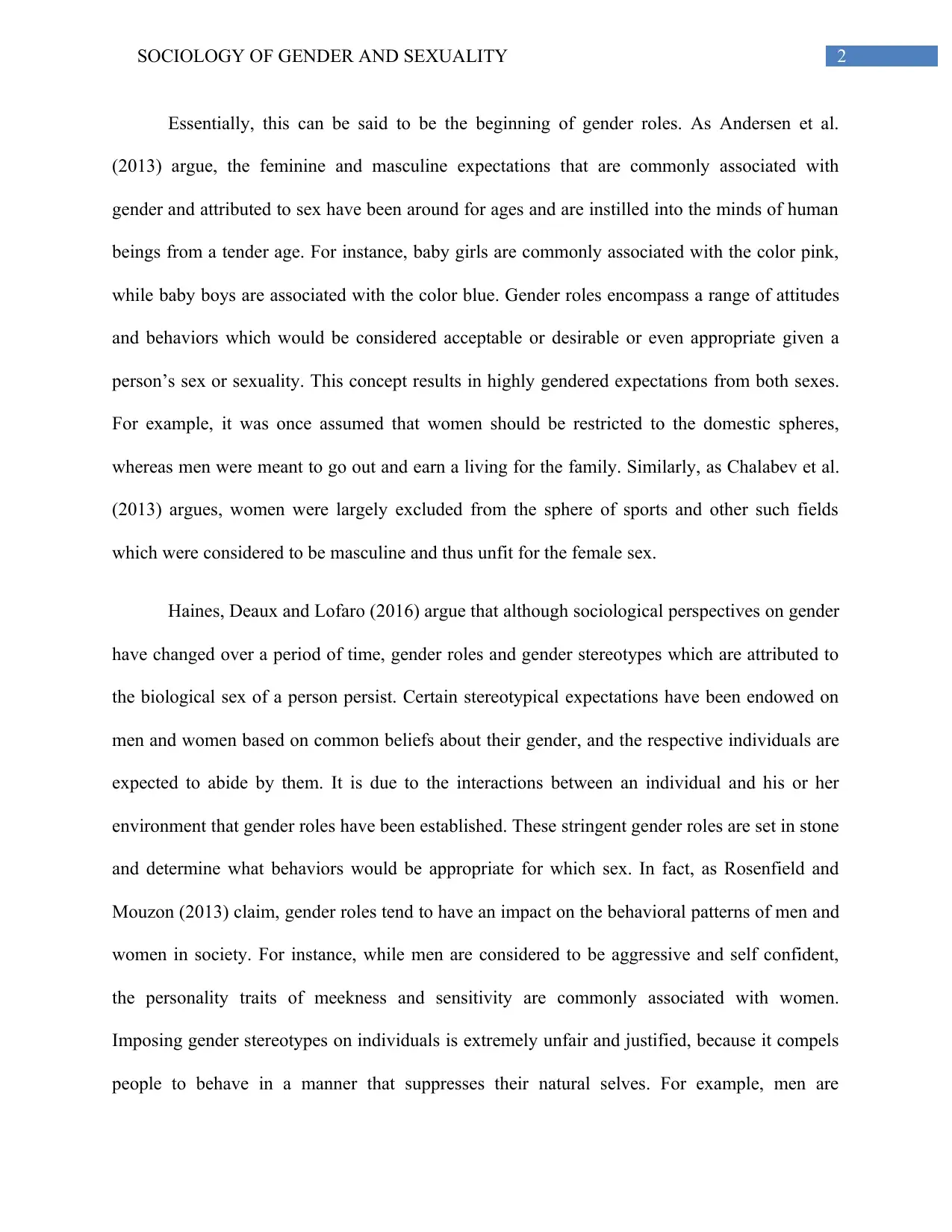
2SOCIOLOGY OF GENDER AND SEXUALITY
Essentially, this can be said to be the beginning of gender roles. As Andersen et al.
(2013) argue, the feminine and masculine expectations that are commonly associated with
gender and attributed to sex have been around for ages and are instilled into the minds of human
beings from a tender age. For instance, baby girls are commonly associated with the color pink,
while baby boys are associated with the color blue. Gender roles encompass a range of attitudes
and behaviors which would be considered acceptable or desirable or even appropriate given a
person’s sex or sexuality. This concept results in highly gendered expectations from both sexes.
For example, it was once assumed that women should be restricted to the domestic spheres,
whereas men were meant to go out and earn a living for the family. Similarly, as Chalabev et al.
(2013) argues, women were largely excluded from the sphere of sports and other such fields
which were considered to be masculine and thus unfit for the female sex.
Haines, Deaux and Lofaro (2016) argue that although sociological perspectives on gender
have changed over a period of time, gender roles and gender stereotypes which are attributed to
the biological sex of a person persist. Certain stereotypical expectations have been endowed on
men and women based on common beliefs about their gender, and the respective individuals are
expected to abide by them. It is due to the interactions between an individual and his or her
environment that gender roles have been established. These stringent gender roles are set in stone
and determine what behaviors would be appropriate for which sex. In fact, as Rosenfield and
Mouzon (2013) claim, gender roles tend to have an impact on the behavioral patterns of men and
women in society. For instance, while men are considered to be aggressive and self confident,
the personality traits of meekness and sensitivity are commonly associated with women.
Imposing gender stereotypes on individuals is extremely unfair and justified, because it compels
people to behave in a manner that suppresses their natural selves. For example, men are
Essentially, this can be said to be the beginning of gender roles. As Andersen et al.
(2013) argue, the feminine and masculine expectations that are commonly associated with
gender and attributed to sex have been around for ages and are instilled into the minds of human
beings from a tender age. For instance, baby girls are commonly associated with the color pink,
while baby boys are associated with the color blue. Gender roles encompass a range of attitudes
and behaviors which would be considered acceptable or desirable or even appropriate given a
person’s sex or sexuality. This concept results in highly gendered expectations from both sexes.
For example, it was once assumed that women should be restricted to the domestic spheres,
whereas men were meant to go out and earn a living for the family. Similarly, as Chalabev et al.
(2013) argues, women were largely excluded from the sphere of sports and other such fields
which were considered to be masculine and thus unfit for the female sex.
Haines, Deaux and Lofaro (2016) argue that although sociological perspectives on gender
have changed over a period of time, gender roles and gender stereotypes which are attributed to
the biological sex of a person persist. Certain stereotypical expectations have been endowed on
men and women based on common beliefs about their gender, and the respective individuals are
expected to abide by them. It is due to the interactions between an individual and his or her
environment that gender roles have been established. These stringent gender roles are set in stone
and determine what behaviors would be appropriate for which sex. In fact, as Rosenfield and
Mouzon (2013) claim, gender roles tend to have an impact on the behavioral patterns of men and
women in society. For instance, while men are considered to be aggressive and self confident,
the personality traits of meekness and sensitivity are commonly associated with women.
Imposing gender stereotypes on individuals is extremely unfair and justified, because it compels
people to behave in a manner that suppresses their natural selves. For example, men are
⊘ This is a preview!⊘
Do you want full access?
Subscribe today to unlock all pages.

Trusted by 1+ million students worldwide
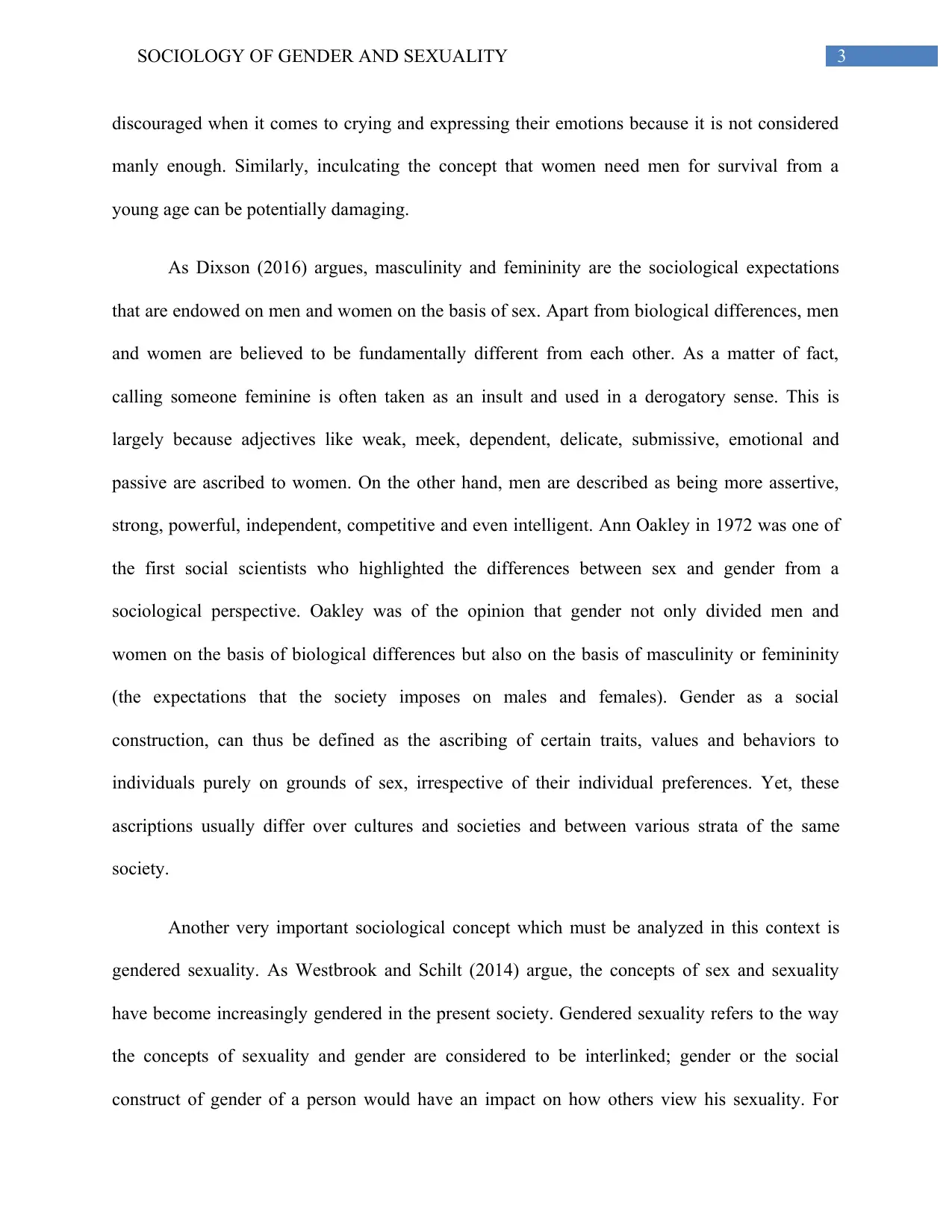
3SOCIOLOGY OF GENDER AND SEXUALITY
discouraged when it comes to crying and expressing their emotions because it is not considered
manly enough. Similarly, inculcating the concept that women need men for survival from a
young age can be potentially damaging.
As Dixson (2016) argues, masculinity and femininity are the sociological expectations
that are endowed on men and women on the basis of sex. Apart from biological differences, men
and women are believed to be fundamentally different from each other. As a matter of fact,
calling someone feminine is often taken as an insult and used in a derogatory sense. This is
largely because adjectives like weak, meek, dependent, delicate, submissive, emotional and
passive are ascribed to women. On the other hand, men are described as being more assertive,
strong, powerful, independent, competitive and even intelligent. Ann Oakley in 1972 was one of
the first social scientists who highlighted the differences between sex and gender from a
sociological perspective. Oakley was of the opinion that gender not only divided men and
women on the basis of biological differences but also on the basis of masculinity or femininity
(the expectations that the society imposes on males and females). Gender as a social
construction, can thus be defined as the ascribing of certain traits, values and behaviors to
individuals purely on grounds of sex, irrespective of their individual preferences. Yet, these
ascriptions usually differ over cultures and societies and between various strata of the same
society.
Another very important sociological concept which must be analyzed in this context is
gendered sexuality. As Westbrook and Schilt (2014) argue, the concepts of sex and sexuality
have become increasingly gendered in the present society. Gendered sexuality refers to the way
the concepts of sexuality and gender are considered to be interlinked; gender or the social
construct of gender of a person would have an impact on how others view his sexuality. For
discouraged when it comes to crying and expressing their emotions because it is not considered
manly enough. Similarly, inculcating the concept that women need men for survival from a
young age can be potentially damaging.
As Dixson (2016) argues, masculinity and femininity are the sociological expectations
that are endowed on men and women on the basis of sex. Apart from biological differences, men
and women are believed to be fundamentally different from each other. As a matter of fact,
calling someone feminine is often taken as an insult and used in a derogatory sense. This is
largely because adjectives like weak, meek, dependent, delicate, submissive, emotional and
passive are ascribed to women. On the other hand, men are described as being more assertive,
strong, powerful, independent, competitive and even intelligent. Ann Oakley in 1972 was one of
the first social scientists who highlighted the differences between sex and gender from a
sociological perspective. Oakley was of the opinion that gender not only divided men and
women on the basis of biological differences but also on the basis of masculinity or femininity
(the expectations that the society imposes on males and females). Gender as a social
construction, can thus be defined as the ascribing of certain traits, values and behaviors to
individuals purely on grounds of sex, irrespective of their individual preferences. Yet, these
ascriptions usually differ over cultures and societies and between various strata of the same
society.
Another very important sociological concept which must be analyzed in this context is
gendered sexuality. As Westbrook and Schilt (2014) argue, the concepts of sex and sexuality
have become increasingly gendered in the present society. Gendered sexuality refers to the way
the concepts of sexuality and gender are considered to be interlinked; gender or the social
construct of gender of a person would have an impact on how others view his sexuality. For
Paraphrase This Document
Need a fresh take? Get an instant paraphrase of this document with our AI Paraphraser
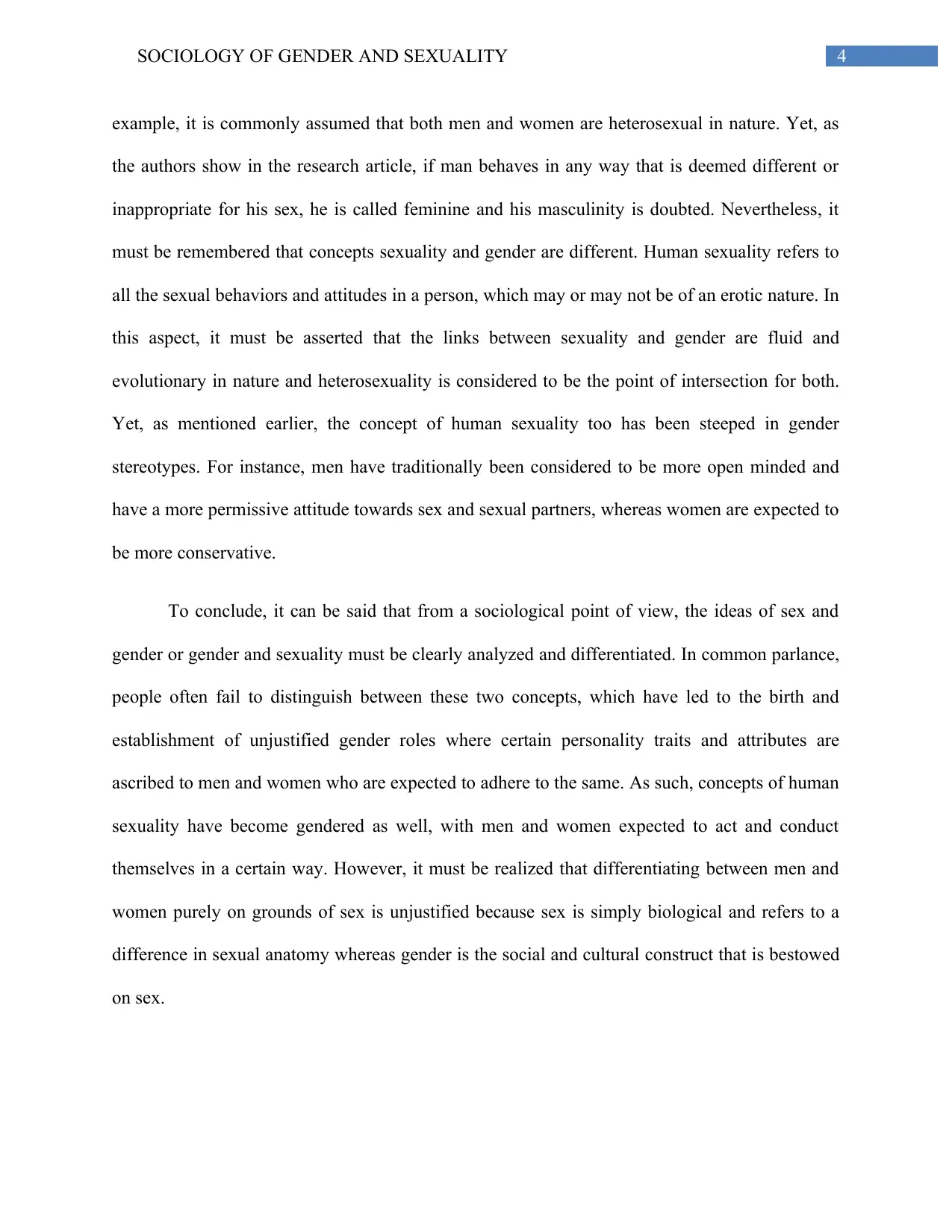
4SOCIOLOGY OF GENDER AND SEXUALITY
example, it is commonly assumed that both men and women are heterosexual in nature. Yet, as
the authors show in the research article, if man behaves in any way that is deemed different or
inappropriate for his sex, he is called feminine and his masculinity is doubted. Nevertheless, it
must be remembered that concepts sexuality and gender are different. Human sexuality refers to
all the sexual behaviors and attitudes in a person, which may or may not be of an erotic nature. In
this aspect, it must be asserted that the links between sexuality and gender are fluid and
evolutionary in nature and heterosexuality is considered to be the point of intersection for both.
Yet, as mentioned earlier, the concept of human sexuality too has been steeped in gender
stereotypes. For instance, men have traditionally been considered to be more open minded and
have a more permissive attitude towards sex and sexual partners, whereas women are expected to
be more conservative.
To conclude, it can be said that from a sociological point of view, the ideas of sex and
gender or gender and sexuality must be clearly analyzed and differentiated. In common parlance,
people often fail to distinguish between these two concepts, which have led to the birth and
establishment of unjustified gender roles where certain personality traits and attributes are
ascribed to men and women who are expected to adhere to the same. As such, concepts of human
sexuality have become gendered as well, with men and women expected to act and conduct
themselves in a certain way. However, it must be realized that differentiating between men and
women purely on grounds of sex is unjustified because sex is simply biological and refers to a
difference in sexual anatomy whereas gender is the social and cultural construct that is bestowed
on sex.
example, it is commonly assumed that both men and women are heterosexual in nature. Yet, as
the authors show in the research article, if man behaves in any way that is deemed different or
inappropriate for his sex, he is called feminine and his masculinity is doubted. Nevertheless, it
must be remembered that concepts sexuality and gender are different. Human sexuality refers to
all the sexual behaviors and attitudes in a person, which may or may not be of an erotic nature. In
this aspect, it must be asserted that the links between sexuality and gender are fluid and
evolutionary in nature and heterosexuality is considered to be the point of intersection for both.
Yet, as mentioned earlier, the concept of human sexuality too has been steeped in gender
stereotypes. For instance, men have traditionally been considered to be more open minded and
have a more permissive attitude towards sex and sexual partners, whereas women are expected to
be more conservative.
To conclude, it can be said that from a sociological point of view, the ideas of sex and
gender or gender and sexuality must be clearly analyzed and differentiated. In common parlance,
people often fail to distinguish between these two concepts, which have led to the birth and
establishment of unjustified gender roles where certain personality traits and attributes are
ascribed to men and women who are expected to adhere to the same. As such, concepts of human
sexuality have become gendered as well, with men and women expected to act and conduct
themselves in a certain way. However, it must be realized that differentiating between men and
women purely on grounds of sex is unjustified because sex is simply biological and refers to a
difference in sexual anatomy whereas gender is the social and cultural construct that is bestowed
on sex.
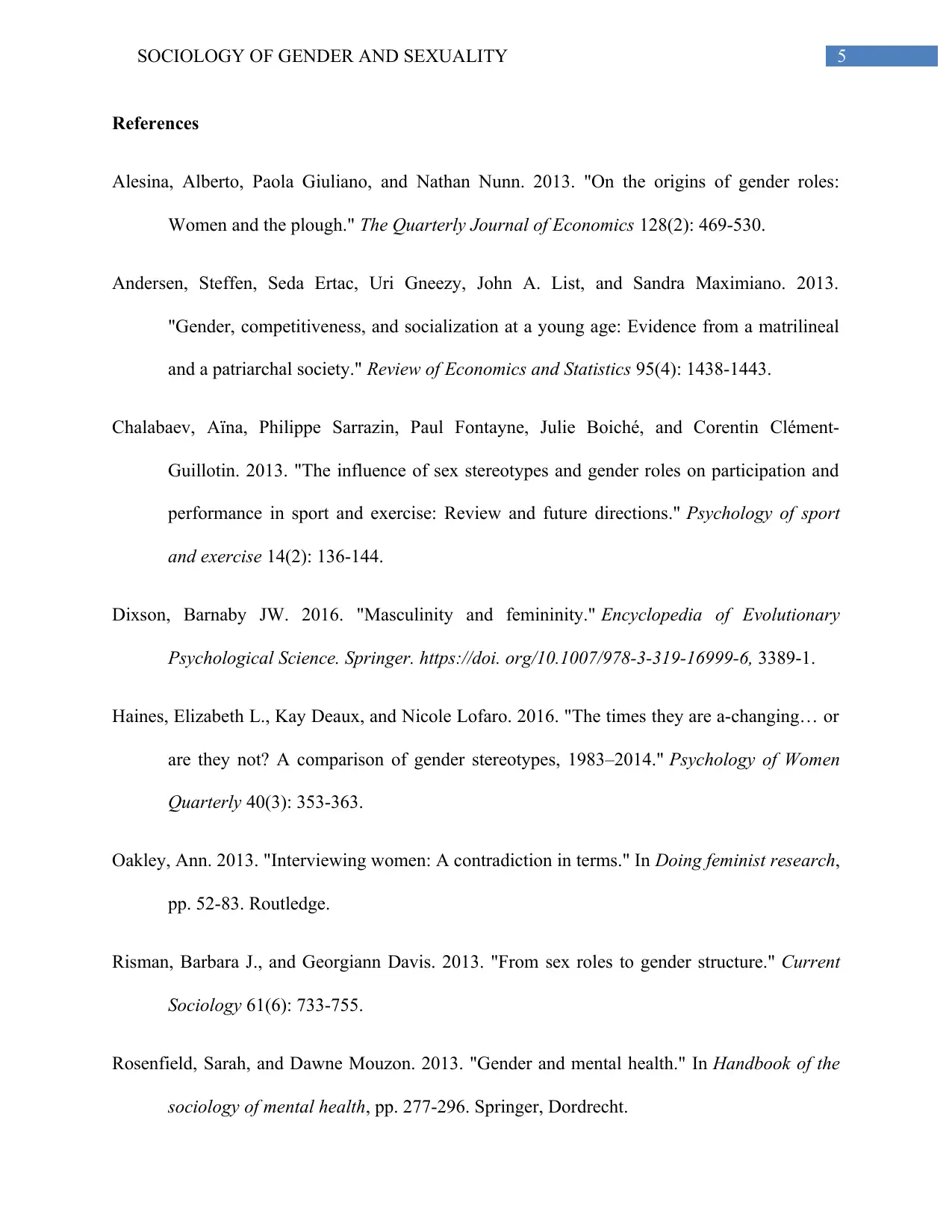
5SOCIOLOGY OF GENDER AND SEXUALITY
References
Alesina, Alberto, Paola Giuliano, and Nathan Nunn. 2013. "On the origins of gender roles:
Women and the plough." The Quarterly Journal of Economics 128(2): 469-530.
Andersen, Steffen, Seda Ertac, Uri Gneezy, John A. List, and Sandra Maximiano. 2013.
"Gender, competitiveness, and socialization at a young age: Evidence from a matrilineal
and a patriarchal society." Review of Economics and Statistics 95(4): 1438-1443.
Chalabaev, Aïna, Philippe Sarrazin, Paul Fontayne, Julie Boiché, and Corentin Clément-
Guillotin. 2013. "The influence of sex stereotypes and gender roles on participation and
performance in sport and exercise: Review and future directions." Psychology of sport
and exercise 14(2): 136-144.
Dixson, Barnaby JW. 2016. "Masculinity and femininity." Encyclopedia of Evolutionary
Psychological Science. Springer. https://doi. org/10.1007/978-3-319-16999-6, 3389-1.
Haines, Elizabeth L., Kay Deaux, and Nicole Lofaro. 2016. "The times they are a-changing… or
are they not? A comparison of gender stereotypes, 1983–2014." Psychology of Women
Quarterly 40(3): 353-363.
Oakley, Ann. 2013. "Interviewing women: A contradiction in terms." In Doing feminist research,
pp. 52-83. Routledge.
Risman, Barbara J., and Georgiann Davis. 2013. "From sex roles to gender structure." Current
Sociology 61(6): 733-755.
Rosenfield, Sarah, and Dawne Mouzon. 2013. "Gender and mental health." In Handbook of the
sociology of mental health, pp. 277-296. Springer, Dordrecht.
References
Alesina, Alberto, Paola Giuliano, and Nathan Nunn. 2013. "On the origins of gender roles:
Women and the plough." The Quarterly Journal of Economics 128(2): 469-530.
Andersen, Steffen, Seda Ertac, Uri Gneezy, John A. List, and Sandra Maximiano. 2013.
"Gender, competitiveness, and socialization at a young age: Evidence from a matrilineal
and a patriarchal society." Review of Economics and Statistics 95(4): 1438-1443.
Chalabaev, Aïna, Philippe Sarrazin, Paul Fontayne, Julie Boiché, and Corentin Clément-
Guillotin. 2013. "The influence of sex stereotypes and gender roles on participation and
performance in sport and exercise: Review and future directions." Psychology of sport
and exercise 14(2): 136-144.
Dixson, Barnaby JW. 2016. "Masculinity and femininity." Encyclopedia of Evolutionary
Psychological Science. Springer. https://doi. org/10.1007/978-3-319-16999-6, 3389-1.
Haines, Elizabeth L., Kay Deaux, and Nicole Lofaro. 2016. "The times they are a-changing… or
are they not? A comparison of gender stereotypes, 1983–2014." Psychology of Women
Quarterly 40(3): 353-363.
Oakley, Ann. 2013. "Interviewing women: A contradiction in terms." In Doing feminist research,
pp. 52-83. Routledge.
Risman, Barbara J., and Georgiann Davis. 2013. "From sex roles to gender structure." Current
Sociology 61(6): 733-755.
Rosenfield, Sarah, and Dawne Mouzon. 2013. "Gender and mental health." In Handbook of the
sociology of mental health, pp. 277-296. Springer, Dordrecht.
⊘ This is a preview!⊘
Do you want full access?
Subscribe today to unlock all pages.

Trusted by 1+ million students worldwide
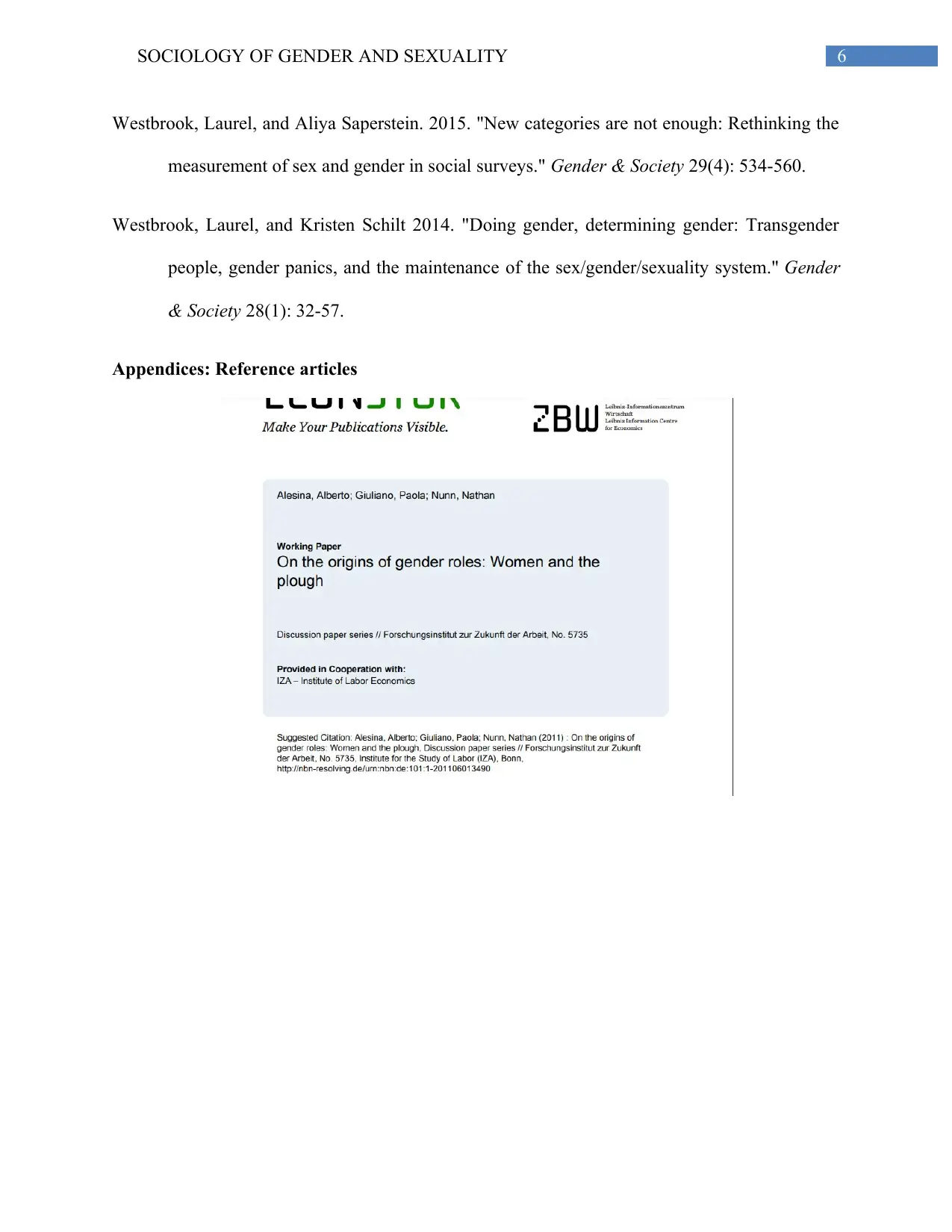
6SOCIOLOGY OF GENDER AND SEXUALITY
Westbrook, Laurel, and Aliya Saperstein. 2015. "New categories are not enough: Rethinking the
measurement of sex and gender in social surveys." Gender & Society 29(4): 534-560.
Westbrook, Laurel, and Kristen Schilt 2014. "Doing gender, determining gender: Transgender
people, gender panics, and the maintenance of the sex/gender/sexuality system." Gender
& Society 28(1): 32-57.
Appendices: Reference articles
Westbrook, Laurel, and Aliya Saperstein. 2015. "New categories are not enough: Rethinking the
measurement of sex and gender in social surveys." Gender & Society 29(4): 534-560.
Westbrook, Laurel, and Kristen Schilt 2014. "Doing gender, determining gender: Transgender
people, gender panics, and the maintenance of the sex/gender/sexuality system." Gender
& Society 28(1): 32-57.
Appendices: Reference articles
Paraphrase This Document
Need a fresh take? Get an instant paraphrase of this document with our AI Paraphraser
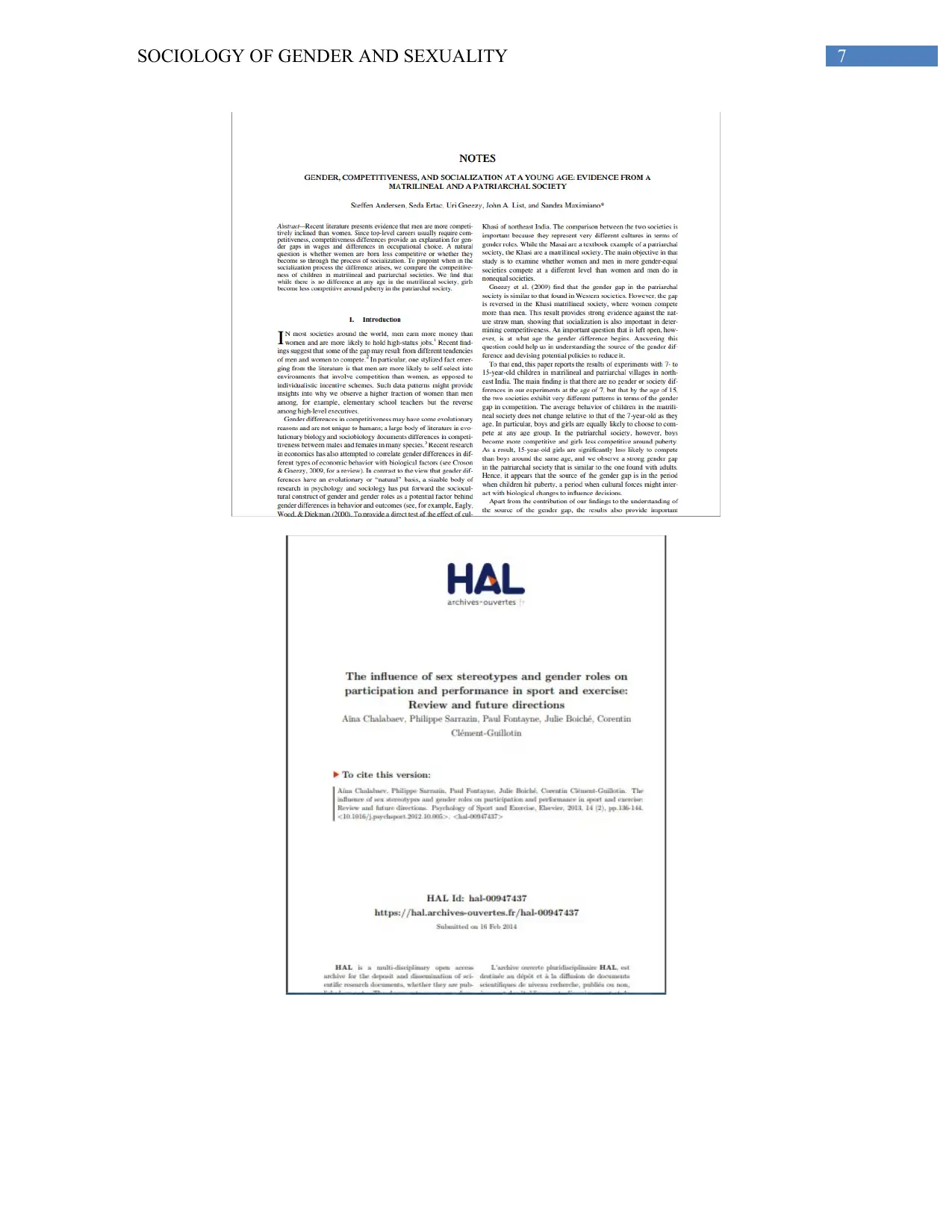
7SOCIOLOGY OF GENDER AND SEXUALITY
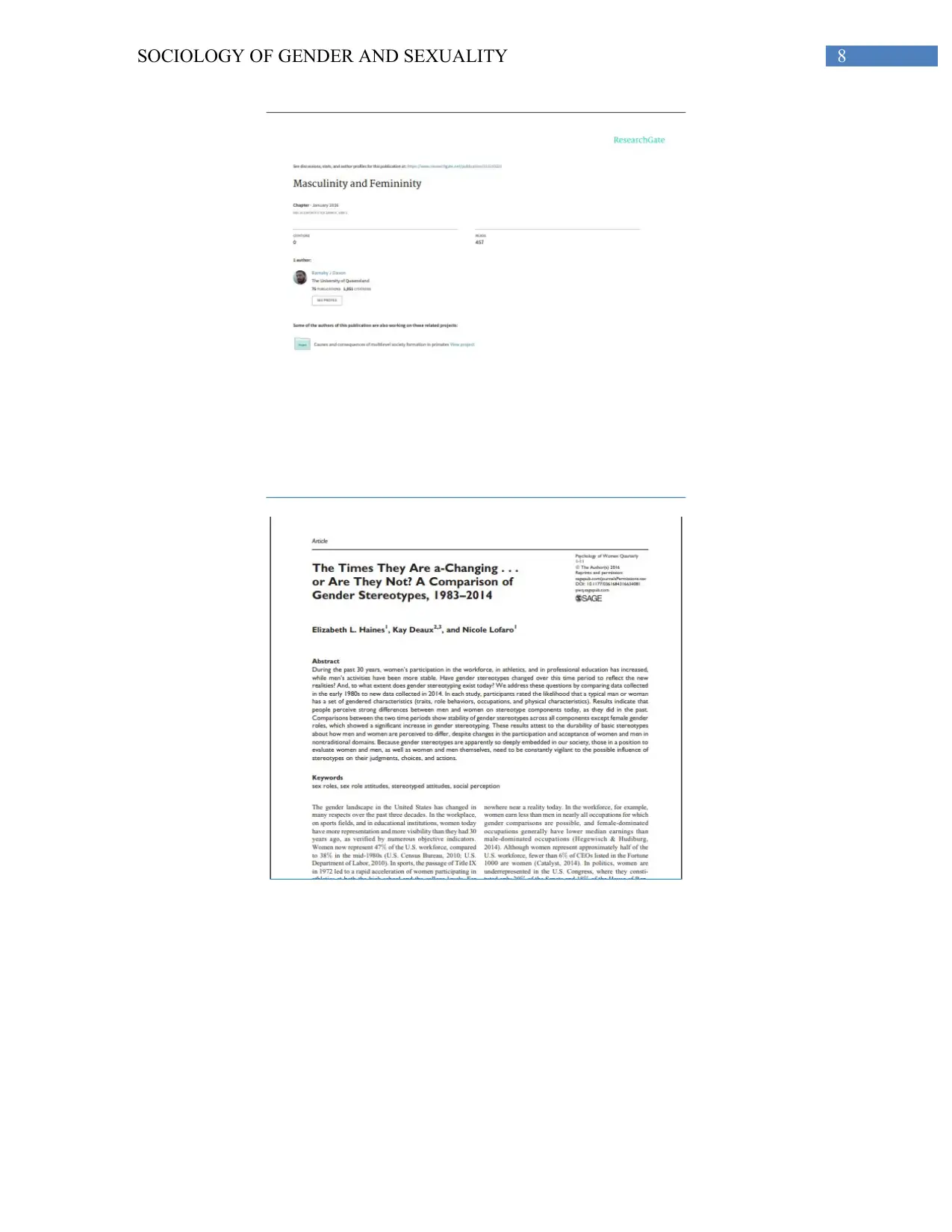
8SOCIOLOGY OF GENDER AND SEXUALITY
⊘ This is a preview!⊘
Do you want full access?
Subscribe today to unlock all pages.

Trusted by 1+ million students worldwide
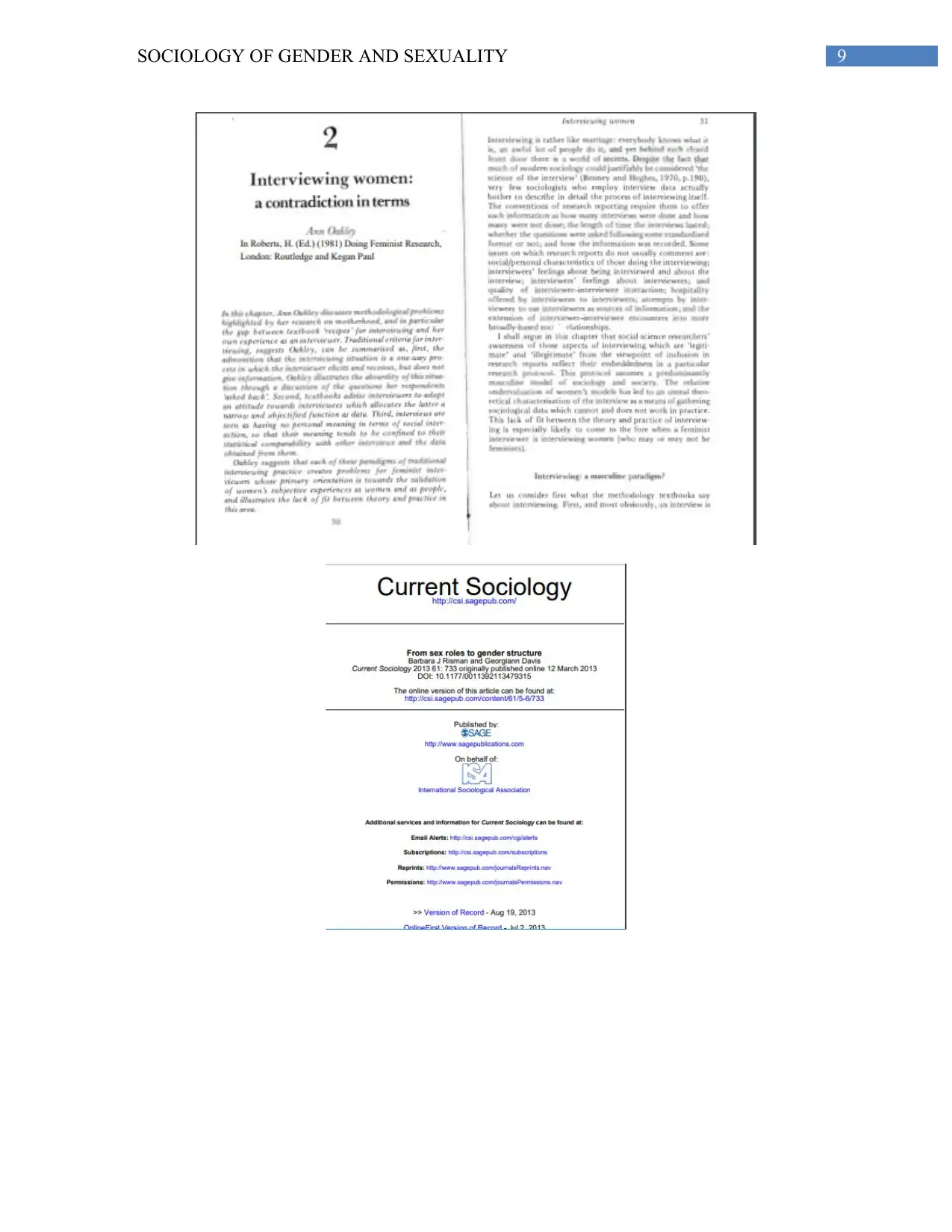
9SOCIOLOGY OF GENDER AND SEXUALITY
Paraphrase This Document
Need a fresh take? Get an instant paraphrase of this document with our AI Paraphraser
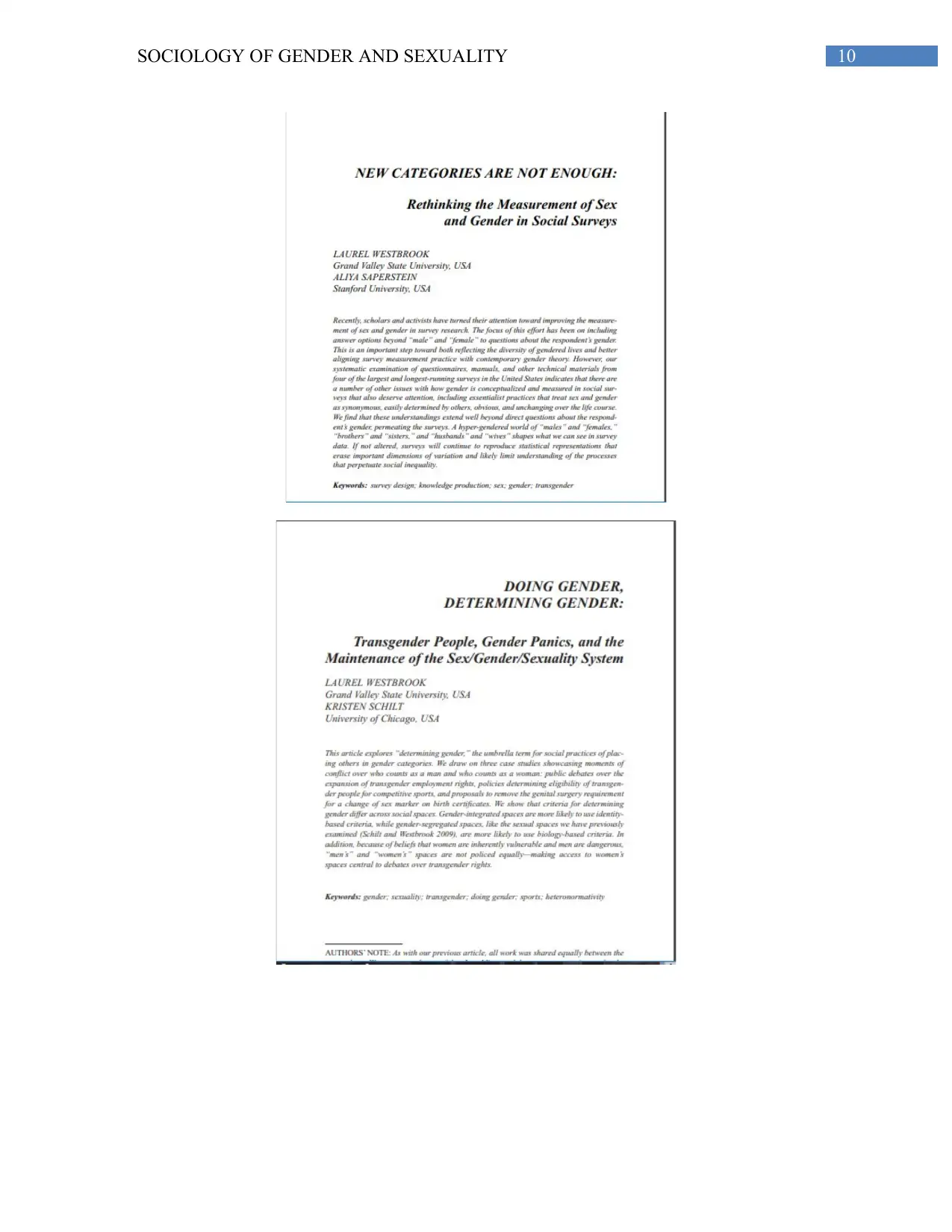
10SOCIOLOGY OF GENDER AND SEXUALITY
1 out of 11
Related Documents
Your All-in-One AI-Powered Toolkit for Academic Success.
+13062052269
info@desklib.com
Available 24*7 on WhatsApp / Email
![[object Object]](/_next/static/media/star-bottom.7253800d.svg)
Unlock your academic potential
Copyright © 2020–2025 A2Z Services. All Rights Reserved. Developed and managed by ZUCOL.




